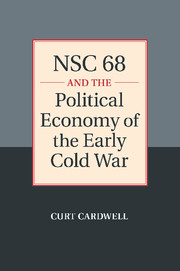Book contents
- Frontmatter
- Contents
- Acknowledgments
- Abbreviations
- Introduction
- 1 NSC 68 and the Problem of Origins
- 2 Multilateralism, the Soviet Threat, and the Origins of the Cold War
- 3 Multilateralism, the Dollar Gap, and the Origins of the Cold War
- 4 The Dollar Gap and Its Discontents
- 5 The British Sterling-Dollar Crisis of 1949–1950
- 6 The Origins and Development of NSC 68
- 7 The Political Economy of Rearmament
- Conclusion
- Select Bibliography
- Index
Conclusion
Published online by Cambridge University Press: 05 July 2011
- Frontmatter
- Contents
- Acknowledgments
- Abbreviations
- Introduction
- 1 NSC 68 and the Problem of Origins
- 2 Multilateralism, the Soviet Threat, and the Origins of the Cold War
- 3 Multilateralism, the Dollar Gap, and the Origins of the Cold War
- 4 The Dollar Gap and Its Discontents
- 5 The British Sterling-Dollar Crisis of 1949–1950
- 6 The Origins and Development of NSC 68
- 7 The Political Economy of Rearmament
- Conclusion
- Select Bibliography
- Index
Summary
The rearmament program known as NSC 68 accomplished its goals, although the effort to establish a multilateral, global economy certainly did not end with NSC 68. Nonetheless, through it the immediate crisis of the postwar era – the impending end of the Marshall Plan in 1952 with the dollar gap still in existence – was overcome and the groundwork laid for that “liberal global economic regime” of which James Baker spoke so glowingly before the Rotary Club in 1994.1 Furthermore, NSC 68 ensconced western Europe, Japan, and many other nations under the U.S. defense umbrella, thereby keeping the “free world” intact when it was otherwise poised to splinter. The United States would not face economic isolation in the western hemisphere, as Paul Nitze had so feared, after all. Nor did the “Western World” collapse in 1952, as a distraught Dean Acheson had predicted if the dollar gap were not overcome. For these multilateralists, military spending, under the auspices of NSC 68, proved the right medicine. Yet, we must ask, was it worth it?
In 1951, the basic assumptions of Soviet intentions as laid down in NSC 68 underwent review as part of a new NSC paper series titled NSC 114. In this context, Soviet expert Charles Bohlen offered two particularly damaging analyses of Acheson's and Nitze's pet project. Both are worthy of quoting at length.
- Type
- Chapter
- Information
- NSC 68 and the Political Economy of the Early Cold War , pp. 259 - 270Publisher: Cambridge University PressPrint publication year: 2011

